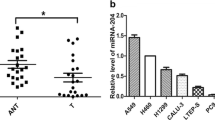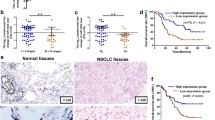Abstract
microRNAs (miRNAs), a family of small non-coding RNA molecules, are implicated in cancer growth and progression. In the present study, we examined the expression and biological roles of miR-590 in non-small cell lung cancer (NSCLC). Compared to normal lung tissues, miR-590 expression was downregulated in primary NSCLCs and, to a greater extent, in corresponding brain metastases. NSCLC cell lines with high metastatic potential had significantly (P < 0.05) lower levels of miR-590 than those with low metastatic potential. Re-expression of miR-590 suppressed NSCLC cell proliferation, colony formation, migration, and invasion in vitro and tumorigenesis in vivo. In contrast, inhibition of miR-590 enhanced the migration and invasion of NSCLC cells. Mechanistic studies revealed that a disintegrin and metalloproteinase 9 (ADAM9) was a direct target of miR-590. Delivery of miR-590 mimic was found to decrease endogenous ADAM9 expression in NSCLC cells. Enforced expression of a miRNA-resistant form of ADAM9 significantly restored the aggressive behaviors in miR-590-overexpressing NSCLC cells. Taken together, our data reveal miR-590 as a tumor suppressor in NSCLC, which is at least partially mediated through targeting of ADAM9. Restoration of miR-590 may provide a promising therapeutic strategy for NSCLC.





Similar content being viewed by others
References
Buettner R, Wolf J, Thomas RK (2013) Lessons learned from lung cancer genomics: the emerging concept of individualized diagnostics and treatment. J Clin Oncol 31:1858–1865
Allemani C, Weir HK, Carreira H, Harewood R, Spika D, Wang XS, Bannon F, Ahn JV, Johnson CJ, Bonaventure A, Marcos-Gragera R, Stiller C, e Silva GA, Chen WQ, Ogunbiyi OJ, Rachet B, Soeberg MJ, You H, Matsuda T, Bielska-Lasota M (2015) surveillance of cancer survival 1995–2009: analysis of individual data for 25,676,887 patients from 279 population-based registries in 67 countries (CONCORD-2). Lancet 385:977–1010
Bui N, Woodward B, Johnson A, Husain H (2016) Novel treatment strategies for brain metastases in non-small-cell lung cancer. Curr Treat Option Oncol 17(5):25
Giebeler N, Zigrino P (2016) A disintegrin and metalloprotease (ADAM): historical overview of their functions. Toxins (Basel) 8:122
Mullooly M, McGowan P, Crown J, Duffy MJ (2016) The ADAMs family of proteases as targets for the treatment of cancer. Cancer Biol Ther. doi:10.1080/15384047.2016.1177684
Hernández I, Moreno JL, Zandueta C, Montuenga L, Lecanda F (2010) Novel alternatively spliced ADAM8 isoforms contribute to the aggressive bone metastatic phenotype of lung cancer. Oncogene 29:3758–3769
Chiu KL, Kuo TT, Kuok QY, Lin YS, Hua CH, Lin CY, Su PY, Lai LC, Sher YP (2015) ADAM9 enhances CDCP1 protein expression by suppressing miR-218 for lung tumor metastasis. Sci Rep 5:16426
Ieguchi K, Tomita T, Omori T, Komatsu A, Deguchi A, Masuda J, Duffy SL, Coulthard MG, Boyd A, Maru Y (2014) ADAM12-cleaved ephrin-A1 contributes to lung metastasis. Oncogene 33:2179–2190
Cai M, Wang Z, Zhang J, Zhou H, Jin L, Bai R, Weng Y (2015) Adam17, a target of Mir-326, promotes EMT-induced cells invasion in lung adenocarcinoma. Cell Physiol Biochem 36:1175–1185
Ota M, Mochizuki S, Shimoda M, Abe H, Miyamae Y, Ishii K, Kimura H, Okada Y (2016) ADAM23 is downregulated in side population and suppresses lung metastasis of lung carcinoma cells. Cancer Sci 107:433–443
Ohtsuka T, Shiomi T, Shimoda M, Kodama T, Amour A, Murphy G, Ohuchi E, Kobayashi K, Okada Y (2006) ADAM28 is overexpressed in human non-small cell lung carcinomas and correlates with cell proliferation and lymph node metastasis. Int J Cancer 118:263–273
Shintani Y, Higashiyama S, Ohta M, Hirabayashi H, Yamamoto S, Yoshimasu T, Matsuda H, Matsuura N (2004) Overexpression of ADAM9 in non-small cell lung cancer correlates with brain metastasis. Cancer Res 64:4190–4196
Lin CY, Chen HJ, Huang CC, Lai LC, Lu TP, Tseng GC, Kuo TT, Kuok QY, Hsu JL, Sung SY, Hung MC, Sher YP (2014) ADAM9 promotes lung cancer metastases to brain by a plasminogen activator-based pathway. Cancer Res 74:5229–5243
Del Vescovo V, Denti MA (2015) microRNA and lung cancer. Adv Exp Med Biol 889:153–177
Li Q, Han Y, Wang C, Shan S, Wang Y, Zhang J, Ren T (2015) MicroRNA-125b promotes tumor metastasis through targeting tumor protein 53-induced nuclear protein 1 in patients with non-small-cell lung cancer. Cancer Cell Int 15:84
Li D, Wei Y, Wang D, Gao H, Liu K (2016) MicroRNA-26b suppresses the metastasis of non-small cell lung cancer by targeting MIEN1 via NF-κB/MMP-9/VEGF pathways. Biochem Biophys Res Commun 472:465–470
Wu X, Liu T, Fang O, Dong W, Zhang F, Leach L, Hu X, Luo Z (2016) MicroRNA-708-5p acts as a therapeutic agent against metastatic lung cancer. Oncotarget 7:2417–2432
Chu Y, Ouyang Y, Wang F, Zheng A, Bai L, Han L, Chen Y, Wang H (2014) MicroRNA-590 promotes cervical cancer cell growth and invasion by targeting CHL1. J Cell Biochem 115:847–853
Pang H, Zheng Y, Zhao Y, Xiu X, Wang J (2015) miR-590-3p suppresses cancer cell migration, invasion and epithelial-mesenchymal transition in glioblastoma multiforme by targeting ZEB1 and ZEB2. Biochem Biophys Res Commun 468:739–745
Liu J, Gao L, Zhang H, Wang D, Wang M, Zhu J, Pang C, Wang C (2013) Succinate dehydrogenase 5 (SDH5) regulates glycogen synthase kinase 3β-β-catenin-mediated lung cancer metastasis. J Biol Chem 288:29965–29973
Wang Z, Ma B, Li H, Xiao X, Zhou W, Liu F, Zhang B, Zhu M, Yang Q, Zeng Y, Sun Y, Sun S, Wang Y, Zhang Y, Weng H, Chen L, Ye M, An X, Liu J (2016) Protein 4.1N acts as a potential tumor suppressor linking PP1 to JNK-c-Jun pathway regulation in NSCLC. Oncotarget 7:509–523
Shtivelman E, Hensing T, Simon GR, Dennis PA, Otterson GA, Bueno R, Salgia R (2014) Molecular pathways and therapeutic targets in lung cancer. Oncotarget 5:1392–1433
Dai Y, Zhang Z, Cao Y, Mehta JL, Li J (2016) MiR-590-5p inhibits oxidized-LDL induced angiogenesis by targeting LOX-1. Sci Rep 6:22607
Luo P, Zhang WF, Qian ZX, Xiao LF, Wang H, Zhu TT, Li F, Hu CP, Zhang Z (2016) MiR-590-5p-meidated LOX-1 upregulation promotes Angiotensin II-induced endothelial cell apoptosis. Biochem Biophys Res Commun 471:402–408
Chang L, Gong F, Cui Y (2015) RNAi-mediated A disintegrin and metalloproteinase 9 gene silencing inhibits the tumor growth of non-small lung cancer in vitro and in vivo. Mol Med Rep 12:1197–1204
Author information
Authors and Affiliations
Corresponding author
Additional information
Fei-fei Wang and Song Wang have contributed equally to this work.
Electronic supplementary material
Below is the link to the electronic supplementary material.
Rights and permissions
About this article
Cite this article
Wang, Ff., Wang, S., Xue, Wh. et al. microRNA-590 suppresses the tumorigenesis and invasiveness of non-small cell lung cancer cells by targeting ADAM9. Mol Cell Biochem 423, 29–37 (2016). https://doi.org/10.1007/s11010-016-2822-y
Received:
Accepted:
Published:
Issue Date:
DOI: https://doi.org/10.1007/s11010-016-2822-y




